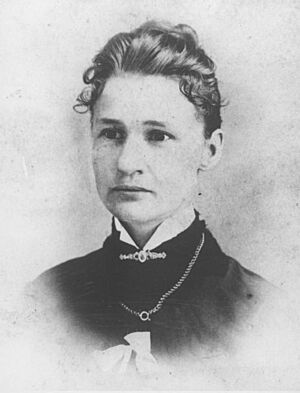Susanna M. Salter facts for kids
Quick facts for kids
Susanna M. Salter
|
|
|---|---|

Salter in 1887
|
|
| Mayor of Argonia, Kansas | |
| In office April 4, 1887 – April 8, 1888 |
|
| Preceded by | William H. Watson |
| Succeeded by | J. S. Baughman |
| Personal details | |
| Born |
Susanna Madora Kinsey
March 2, 1860 Lamira, Ohio |
| Died | March 17, 1961 (aged 101) Norman, Oklahoma |
| Resting place | Argonia Cemetery |
| Political party | Prohibition |
| Spouses |
Lewis Allison Salter
(m. 1880; died 1916) |
| Relations | Mary Elizabeth Clark (great niece) |
| Children | 9 |
| Alma mater | Kansas State Agricultural College |
Susanna Madora Salter (born Kinsey; March 2, 1860 – March 17, 1961) was an American politician and activist. She made history by becoming the first woman elected mayor in the United States. She was also one of the first women to hold any political office in the country. She served as mayor of Argonia, Kansas.
Early Life and Education
Susanna Madora Kinsey was born on March 2, 1860. Her birthplace was near a small community called Lamira in Ohio. Her parents, Oliver and Terissa Ann White Kinsey, were descendants of Quaker families from England.
When Susanna was 12, her family moved to Kansas. They settled on an 80-acre farm near Silver Lake. In 1878, she started college at Kansas State Agricultural College. Today, this school is known as Kansas State University. She was able to skip her first year because she had taken college-level classes in high school. However, she had to leave college due to illness just six weeks before graduating.
While in college, she met Lewis Allison Salter. He wanted to become a lawyer. His father, Melville J. Salter, had been the Lieutenant Governor of Kansas. Susanna and Lewis married soon after. They moved to Argonia. There, Susanna became very active in local groups. These included the Woman's Christian Temperance Union and the Prohibition Party. She even met Carrie Nation, a famous activist who worked to ban alcohol.
In 1883, Susanna gave birth to the first baby born in Argonia. His name was Francis Argonia Salter. Susanna and Lewis had nine children in total. One of their children was born while Susanna was mayor but died as a baby. After Argonia became an official city in 1885, her father became the first mayor. Her husband was elected as the city clerk.
Becoming Mayor
Susanna Salter was elected mayor of Argonia on April 4, 1887. Her election was quite a surprise! A group of men had put her name on the ballot as a joke. They hoped she would lose badly. Their goal was to make women look bad and stop them from getting involved in politics.
Candidates' names did not have to be public before election day. So, Susanna herself did not know she was on the ballot until the polls opened. On election day, she agreed to serve if elected. The Woman's Christian Temperance Union then changed their minds. They had their own candidate, but they decided to vote for Salter instead.
Also, the local Republican Party leader sent people to her home. They confirmed she would serve if she won. The Republicans then agreed to vote for her. This helped her win the election by a large two-thirds majority.
Susanna had some advantages before becoming mayor. Her father was the first mayor of Argonia. Her father-in-law had been the lieutenant governor of Kansas. Her time as mayor was not filled with big events. However, her election got a lot of attention from newspapers across the country. People debated if other towns should elect women mayors. Some people objected to "petticoat rule" (meaning women in charge). Others decided to "wait and see" how things would go.
A reporter from New York Sun attended one of her first city council meetings. He wrote about the mayor's dress and hat. He said she led the meeting with great respect. He noted that she often stopped discussions that were not important. This showed she was good at following meeting rules. News about her election reached newspapers as far away as Sweden and South Africa. For her year of service, she was paid one dollar. After one year, she chose not to run for mayor again.
Later Life
After her time as mayor, Susanna and her family stayed in Argonia. In 1893, her husband bought land in Alva, Oklahoma (then Oklahoma Territory). Ten years later, they moved to Augusta in Woods County, Oklahoma Territory. Her husband worked as a lawyer there. He also started a newspaper called the Headlight.
They later moved to Carmen, Oklahoma. Susanna's husband passed away in 1916. After that, she moved to Norman, Oklahoma. She went with her younger children while they studied at the University of Oklahoma. She lived in Norman for the rest of her life. She remained interested in religious and political topics. However, she never ran for elected office again.
Death
Susanna Salter died on March 17, 1961, in Norman, Oklahoma. This was two weeks after her 101st birthday. She was buried in Argonia, next to her husband.
Honors and Legacy
In 1933, a special bronze plaque was placed in Argonia's public square. It honored Salter for being the first woman mayor in the United States.
The house where she lived as mayor was added to the National Register of Historic Places in September 1971. This means it is recognized as an important historical place.
Susanna Salter is also the subject of a children's book. It is called A Vote for Susanna: The First Woman Mayor (published in 2021).
See also
 In Spanish: Susanna M. Salter para niños
In Spanish: Susanna M. Salter para niños
- List of first women mayors in the United States


